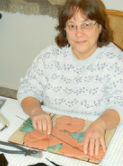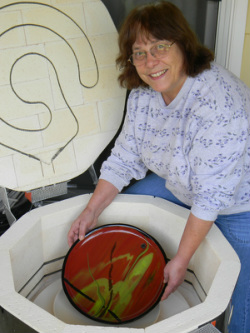Glass Process
Glass fusing is a labor of love. This is a very time consuming process, but the results are beautiful. All of our glass is compatible - meaning the rate of expansion and contraction is the same. We take flat sheets of glass, hand cut and assemble in layers to make an original design. Many of Nancy's large pieces have 3 & 4 layers of glass and are fired in a kiln an average of 3 - 4 times. Brian's pattern bar pieces usually take 4 firings to complete. Each kiln firing averages 15 - 24+ hours, depending on the size and thickness of the glass pieces.

Many times Nancy will make a glass piece using a coated iridescent glass. When light or sun shines on it, the appearance changes in a home throughout the day with sparkles. She also uses dicro glass for accents in many pieces. Dicro glass is usually used in jewelry for its color brilliance.
She specializes in glass art which has tactile dimension (ie: Flowers) and / or color depth variation. Both take multiple firings to achieve, firing the flatest layer first and then adding an additional layer(s) and fire again at a lower temperature.
A Little Glass History -
She specializes in glass art which has tactile dimension (ie: Flowers) and / or color depth variation. Both take multiple firings to achieve, firing the flatest layer first and then adding an additional layer(s) and fire again at a lower temperature.
A Little Glass History -
Glass Fusing (also called Warm glass) is a very old labor intensive technique with rudimentary beginnings
dating from about 2000 BC. The process allows layers of cut glass to melt together (fuse) in a kiln. It looks like
when Glass Blowing (Hot Glass) began, glass fusing fell out of favor. A revival of this old process began about
60 years ago and has expanded greatly.
dating from about 2000 BC. The process allows layers of cut glass to melt together (fuse) in a kiln. It looks like
when Glass Blowing (Hot Glass) began, glass fusing fell out of favor. A revival of this old process began about
60 years ago and has expanded greatly.
Fusing Terms

Full Fuse -
Usually the first firing step in a kiln. Fires flat on kiln shelf.
Takes sufficient heat and time to fully melt the flat layers of glass together into a single piece - usually fire at 1480 degrees. This process can be repeated as needed.
Tack Fuse -
Usually the second step. Fires flat on kiln shelf.
Additional flat layers of glass are melted onto but not fully into the base glass. This is
accomplished by firing at a lower temperature - 1350 to 1450 degrees - resulting in tactile dimension of the glass. This process can also be repeated as needed.
Slump -
This is often the final step. Lay fused./ tack glass on a mold.
Allows the flat fused glass to soften just enough to conform to the shape of a mold at still a
lower temperature - 1240 degrees.
Pattern Bar -
The initial design and planning of this process takes a great amount of time for the pattern to come out close to expectations. Glass is cut / designed, loaded into a contained shape on a kiln shelf and then melted together at 1550 to 1650 degrees. The resulting glass bar is then sliced into strips, reassembled into a design, and then refused together and then shaped. There are various levels of difficulty in designing pattern bars with the complex type being far and away the most difficult. This type is what we do best.
Pot Melt -
Cut pieces of glass are loaded into a container that has a hole in the bottom and placed above another container on a kiln shelf. When the kiln temperature reaches 1550 to 1650 degrees the glass melts and drips through the hole of the upper container into the bottom container forming a shape of glass. This could be a bar which is then sliced, redesigned and refused or it could be a flattened shape which could be then made into a plate / bowl.
Strip Built -
We take flat sheets of glass and cut strips. We then take the strips and place them on edge to form a design. Some times this is done to get "Windows" in a design or we form borders around other glass such as the pattern bars.
Usually the first firing step in a kiln. Fires flat on kiln shelf.
Takes sufficient heat and time to fully melt the flat layers of glass together into a single piece - usually fire at 1480 degrees. This process can be repeated as needed.
Tack Fuse -
Usually the second step. Fires flat on kiln shelf.
Additional flat layers of glass are melted onto but not fully into the base glass. This is
accomplished by firing at a lower temperature - 1350 to 1450 degrees - resulting in tactile dimension of the glass. This process can also be repeated as needed.
Slump -
This is often the final step. Lay fused./ tack glass on a mold.
Allows the flat fused glass to soften just enough to conform to the shape of a mold at still a
lower temperature - 1240 degrees.
Pattern Bar -
The initial design and planning of this process takes a great amount of time for the pattern to come out close to expectations. Glass is cut / designed, loaded into a contained shape on a kiln shelf and then melted together at 1550 to 1650 degrees. The resulting glass bar is then sliced into strips, reassembled into a design, and then refused together and then shaped. There are various levels of difficulty in designing pattern bars with the complex type being far and away the most difficult. This type is what we do best.
Pot Melt -
Cut pieces of glass are loaded into a container that has a hole in the bottom and placed above another container on a kiln shelf. When the kiln temperature reaches 1550 to 1650 degrees the glass melts and drips through the hole of the upper container into the bottom container forming a shape of glass. This could be a bar which is then sliced, redesigned and refused or it could be a flattened shape which could be then made into a plate / bowl.
Strip Built -
We take flat sheets of glass and cut strips. We then take the strips and place them on edge to form a design. Some times this is done to get "Windows" in a design or we form borders around other glass such as the pattern bars.